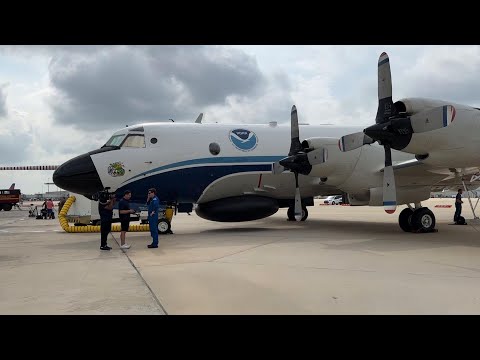(10 May 2024)
RESTRICTION SUMMARY:
++SOUNDBITES SEPARATED BY BLACK FRAMES++
++EDIT ENDS ON SOUNDBITE++
ASSOCIATED PRESS
Sanford, Florida – 10 May 2024
1. Wide of a WP-3D plane, a NOAA "hurricane hunter" aircraft
2. SOUNDBITE (English) William Wysinger, NOAA flight engineer:
"This plane is a WP-3 delta. It is a plane that we use to fly through hurricanes."
++BLACK FRAMES++
3. SOUNDBITE (English) William Wysinger, NOAA flight engineer:
"You have a lot of systems on board for collecting data, which is kind of our primary goal is to collect as much data as possible on these storms, for research. The plane is a propeller plane. It has four big props outside. And we like those engines because they provide us instantaneous power in storms, which is something that you, that you really need in turbulent air."
++BLACK FRAMES++
4. SOUNDBITE (English) William Wysinger, NOAA flight engineer:
"We take about 11 to 17 people on flights. That includes the crew required to fly the plane into the storm and then any scientists from National Weather Service, National Hurricane Center, or HRD (Hurricane Research Division)
++BLACK FRAMES++
5. SOUNDBITE (English) William Wysinger, NOAA flight engineer:
"We bring as many snacks as possible. Oftentimes we have crew members that can cook meals. We have a microwave in the back, a fridge, and we have plugs for, for hot plates and things like that."
++BLACK FRAMES++
6. SOUNDBITE (English) William Wysinger, NOAA flight engineer:
"The obvious answer is that it’s very bumpy. I liken it a lot to riding an old wooden roller coaster at the worst of times. So it does, it does get very turbulent, as you might imagine. But then some storms are not as bumpy, and it’s, it’s, it’s a little surprising."
++EDIT ENDS ON SOUNDBITE++
STORYLINE:
With the 2024 hurricane season expected to be busier than average, the nation’s top federal, state and local disaster and forecasting officials came to Sanford, Florida, on Friday to advise residents on how best to prepare.
The officials in Sanford brought along two “hurricane hunter” planes used in the daredevil business of flying into the middle of storms to gather data about their intensity and direction.
The WP-3D, operated by the National Oceanic and Atmospheric Administration, and the WC-130J, flown by the U.S. Air Force Reserve, fly straight into the storms’ eyewall, usually three times during a flight.
The aim of the hair-raising trips is to gather information that can help officials on the ground make decisions such as when to order people to evacuate.
NOAA’s propeller plane typically has 11 to 17 people on board during flights through hurricanes, including the crew and scientists.
Since flights usually last eight hours, the crew members bring plenty of snack food, and there is a microwave, refrigerator and a hot plate for cooking more elaborate meals.
Although the rides can be very bumpy, sometimes they aren’t as turbulent as expected and crew members don’t realize that they already are in the eye of a hurricane, said William Wysinger, a NOAA flight engineer who has flown on a dozen missions through hurricanes.
“I liken it to riding an old wooden roller coaster during the worst of times,” Wysinger said.
The National Hurricane Center is predicting that the upcoming Atlantic and Gulf season, which runs from June 1 to Nov. 30, will exceed the yearly average of seven tropical storms and seven hurricanes, and that three of the storms will be major.
AP video shot by Mike Schneider
===========================================================
Find out more about AP Archive: http://www.aparchive.com/HowWeWork
Twitter: https://twitter.com/AP_Archive
Facebook: https://www.facebook.com/APArchives
Instagram: https://www.instagram.com/APNews/
You can license this story through AP Archive: http://www.aparchive.com/metadata/youtube/6deb810488274cda8d8a58036d07360e





